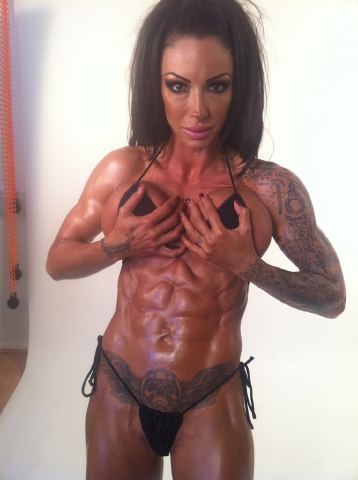
Above: Jodie Marsh
Jodie Marsh has made headlines in the UK this week when she competed in an amateur bodybuilding event. She trimmed down from a size 12 to a size 5 in 8 weeks. She was a contestant from the Big Brother UK.
Her secret and how to make it work for you?
She ate “15 egg whites and seven protein shakes a day - cutting carbohydrates out of her diet entirely.” Jodie claims to have gone from 25% body fat to 10% in the eight week blitzkrieg workout. Jodie worked out with a personal trainer in Essex, Tim Sharp.
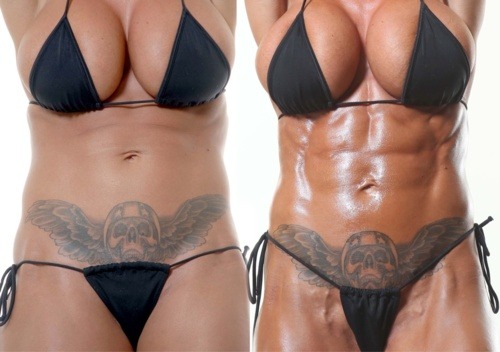
Above: Jodie Marsh before and after
Jodie’s daily workouts:
- 3 hours of cardio
- 2 hours of weights
- 1 hour of abs
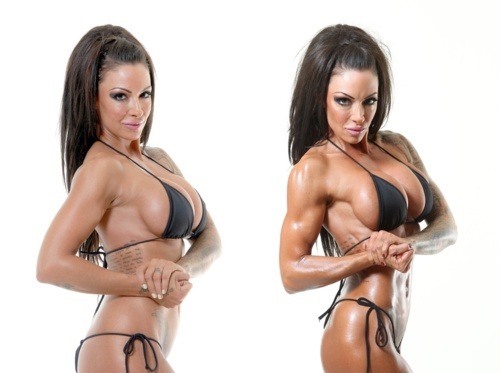
Above: Jodie Marsh before and after
The truth about getting the elusive six pack:
I’ve helped train top amateur bodybuilders and have trained with many professional bodybuilders. The diet Jodie went on is what’s called a pre-contest diet. Actually, you can’t go 8 weeks without any carbs. When you’re dieting for fat loss you have to workout and do your cardio and eat a high protein diet while lowering sodium and carbohydrates. Sodium retains water - it’s also an integral electrolyte, so sodium is only tapered off the last week before the show.
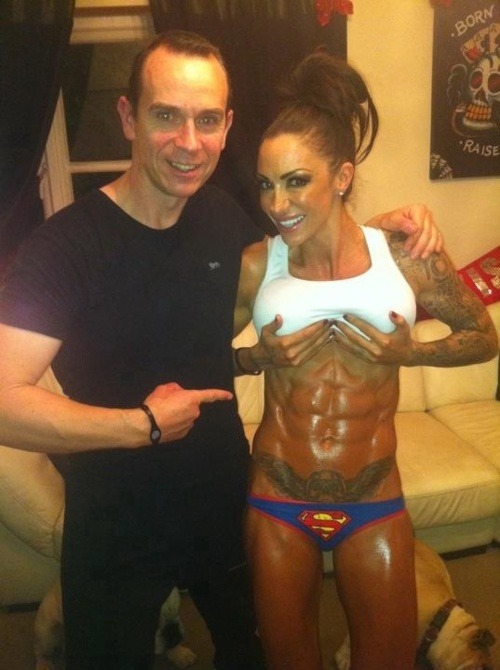
Above: Trainer, Tim Sharp with Jodie Marsh
I’ll go over how much protein you should be eating when you’re training for muscle hypertrophy - which means putting on muscle - and trying to lose body fat. When it comes to cardio everybody’s different: some people can get away with 1 hour of cardio a day while others (like Ronnie Coleman and Kai Greene) resort to 3 hours of cardio pre-contest.
The good news is, you don’t have to go so overboard to get the Jodie Marsh look - carbohydrates are important. When it comes to carbs make sure they’re complex carbohydrates - that means they release glucose at a much slower rate than simple carbs. You’ll also wants carbs high in fibre like legumes. If you eat egg whites or eggs with half a cup of cooked lentils you’ll have 4 hours of food in you. You don’t need so much protein either - it’ll tax your adrenal glands and lead to gout or crystallization of uric acid in your joints.
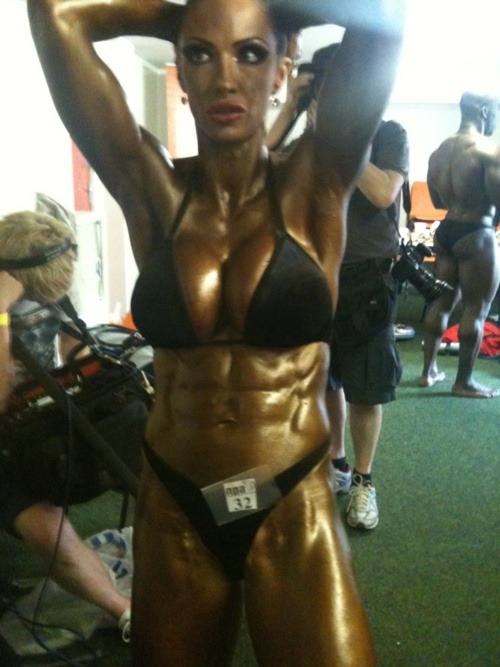
Above: Jodie Marsh at the bodybuilding show
Great sources of protein (preferably free run and organic):
- Lean beef
- Eggs
- Egg whites
- Bison
- Turkey
- Fish (Salmon, Tilapia, etc.)
- Chilli (Whole Foods makes the best one IMO)
- Protein pancakes (whole wheat flour, protein powder, eggs)
Preferable complex carbohydrates:
- Legumes such as lentils, kidney beans, Azuki beans
- Brocoli
- Oatmeal
- Brown rice or organic Jasmine rice

Above: Jodie Marsh
The Great Change in Hypertrophy Training: Doing Less Work!!
The article is entitled, “Low-Load Volume Resistance Exercise Stimulates Muscle Protein Synthesis More Than High-Load Low Volume Resistance Exercise in Young Men.” It was published in August 2010. Not ‘broscience’ - a jargon term describing gym rats dreaming up ideas without scientific fact.
What Stuart M. Phillips et al. discovered is working out at high volume at 30% of your 1RM (one rep max) until failure (and 4 sets) was just as beneficial as working out at 70-80% of your 1RM for 5-10 reps for 4 sets. This is astounding news. Think of the implications - which I’ll get into shortly.

Above: Jodie with trainer Tim
Fact Check:
- Resistance exercise stimulates the synthesis of skeletal muscle proteins, which eventually expressed as muscle hypertrophy
- It is commonly recommended that high-load contractions (i.e. ≥70% of 1RM) be performed to provide an optimal stimulus for muscle growth
- It has recently been established, however, that myofibrillar (MYO) protein synthesis is already maximally stimulated at 60% 1RM, in the post-absorptive state, with no further increase at higher load intensities (i.e., 75-90% 1RM)
- Performance of low-load contractions (~20% 1RM) with vascular occlusion is sufficient to induce an increase in mixed muscle (MIX) protein synthesis, which explains the significant improvements in muscle size and strength, equivalent to those seen in higher contractile intensities, that occur with blood flow occluded training
- Collectively, these data suggest that heavy (i.e., high intensity) external loads are not a prerequisite to elicit increases in muscle protein synthesis and ultimately muscle hypertrophy
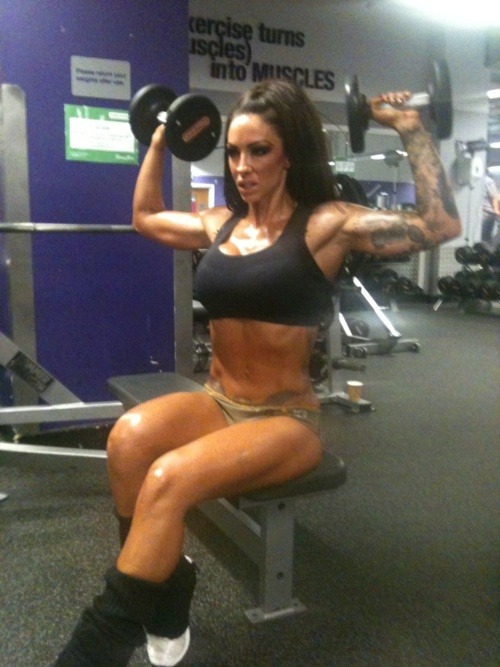
Above: Jodie working out
Discussion:
We report for the first time that low-load high volume resistance exercise (30FAIL) is more effective at increasing muscle protein synthesis than high-load volume resistance exercise (90FAIL).” “In contrast to recommendations, that heavy loads (i.e., high intensity) are necessary to optimally stimulate MYO protein synthesis, it is now apparent that the extent of MYO protein synthesis after resistance exercise is not entirely load dependent, but appears to be related to exercise volume and, we speculate, to muscle fibre activation and most likely to the extent of type II fibre recruitment.
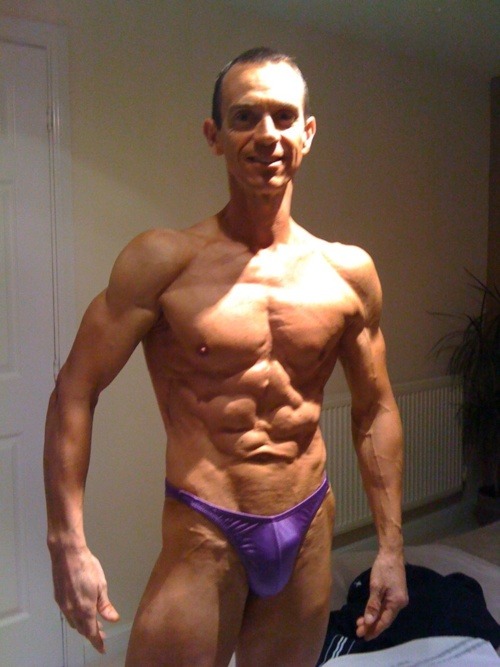
Above: Trainer Tim Sharp
Conclusions/Significance:
These results suggest that low-load high volume resistance exercise is more effective in inducing acute muscle anabolism than high-load low volume or work matched resistance exercise modes.
In conclusion, we have demonstrated that low-load high volume resistance exercise has a potent stimulatory effect on anabolic signalling molecules, MyoD and myogenin mRNA expression and muscle protein synthesis. Our results support previous findings that demonstrated after 16 weeks of isometric training at 30% maximal voluntary contraction that significant increases in fibre area can be achieved. Although, the contraction type employed in the current study (i.e., dynamic) differed from Alway and colleagues (i.e., isometic), our data provides further support that low-load contractions performed with numerous repetitions or high-load contractions performed for fewer repetitions will result in similar training induced gains in muscle hypertrophy as previously suggested, or even superior gains, as results from the current study would predict. This premise is further supported by data which demonstrates that short-term changes in muscle protein synthesis are predictive of training induced gains in muscle mass; however, a training study in which these distinctly different exercise loads (90FAIL and 30FAIL) are utilized is clearly warranted to confirm our speculation.

Above: Transformed Jodie Marsh
Layman’s Terms:
In an interview, Phillips says that you should workout until failure at 30% of your 1RM for 4 sets. It’s important, he stresses, that you don’t count the reps nor stop short of failure.
What this means:
- This research means you can now train for muscle hypertrophy without sacrificing your joints
- You can now train without investing in heavy weights or machines
- It means clients/patients who are compromised by a disability (i.e. low back pain) can still train for hypertrophy
- Patients coming out of rehab can now engage in hypertrophy training
- The elderly can now train for muscle hypertrophy
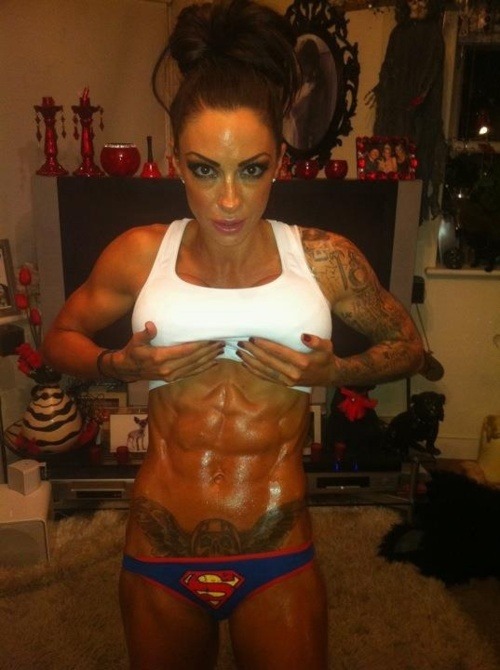
Above: Jodie Marsh
What to Eat Post Workout?
Phillips’ peer-reviewed journal titled ”Consumption of fat-free milk after resistance exercise promotes greater lean mass accretion than does consumption of soy or carbohydrate in young, novice, male weightlifters,” illustrates that 500 mL of fat-free milk is the best post workout supplement. The journal is attached in this email as well. 56 men in three cohorts, divided by the Milk group, the Soy group and the Control group, they found that the Milk group saw a greater increase in muscle fibres.
We conclude that chronic postexercise consumption of milk promotes greater hypertrophy during the early stages of resistance training in novice weightlifters when compared with isoenergetic soy or carbohydrate consumption.
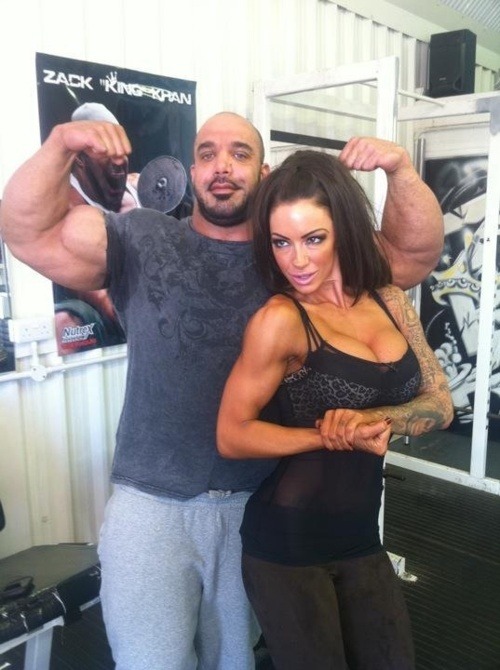
Above: IFBB pro bodybuilder Zack “King” Khan posing with Jodie Marsh
Fact check:
- Casein ingestion induced a more positive whole-body leucine balance than did whey
- Recent findings showed that milk proteins appear superior to, or at least equivalent to, either isolated whey or casein alone in terms of supporting postprandial dietary nitrogen utilization
- “We have recently shown that when milk and soy proteins are ingested after resistance exercise, milk protein resulted in a more positive net amino acid balance and a greater postexercise stimulation of protein synthesis”
Layman’s terms:
Drink 500 mL of fat-free fluid milk within 1 hour of training

Above: Jodie with trainer Tim showing off the spoils of war
How Much Protein to Consume for Anabolic Growth? And What to Consume?
Phillips’ et al also found the magic dose of protein per serving and per day. This appeared in their peer-reviewed article titled, “Ingested protein dose response of muscle and albumin protein synthesis after resistance exercise in young men.” What they discovered is the magic number is 20 grams of whole egg protein, 5-6 times a day. According the audio interview, it doesn’t matter if one subject has an increased muscle mass over another individual because it’s relative to plasma quantity (i.e. a 150 lbs man has approximately 3.5 L of plasma vs. the 260 lbs bodybuilder has 3.7 of plasma). Blood distributes the protein throughout the body - so it makes no sense to increase the doses!! Interesting. They tested against 0, 5, 10, 20 and 40 g whole egg protein (which he concludes is superior to whey protein).
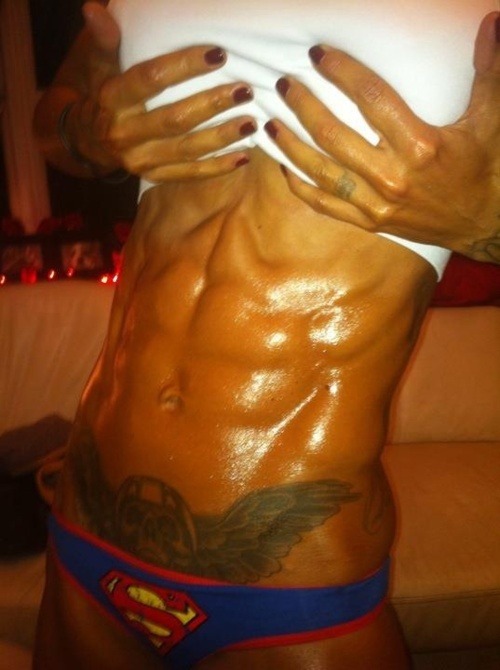
Above: Jodie ripped!
Results:
Ingestion of 20 g intact protein is sufficient to maximally stimulate MPS (ingested protein dose of muscle) and APS (albumin protein synthesis) after resistance exercise. Phosphorylation of candidate signalling proteins was not enhanced with any dose of protein ingested, which suggested that the stimulation of MPS after resistance may be related to amino acid availability. Finally, dietary protein consumed after exercise in excess of the rate at which it can be incorporated into tissue protein stimulates irreversible oxidation. “In summary, our data are the first, to our knowledge, to demonstrate that muscle protein synthesis responds to increasing protein intake in a dose-dependent manner after resistance exercise and reaches a maximal stimulation after ingestion of 20 g high-quality protein. We observed little change in the phosphorylation status of signalling proteins shown to activate the translational machinery, which suggests that the main driver of muscle anabolism with feeding after resistance exercise may simply be amino acid availability. We also report that APS is stimulated by increasing protein ingestion after resistance exercise and reached a plateau at 20 g ingested protein. The stimulation of leucine oxidation after ingestion of 20 and 40 g protein suggests that these doses represent an excess of protein. In conclusion, our data indicate 20 g intact high-quality protein is sufficient to maximize the anabolic response to resistance exercise.”
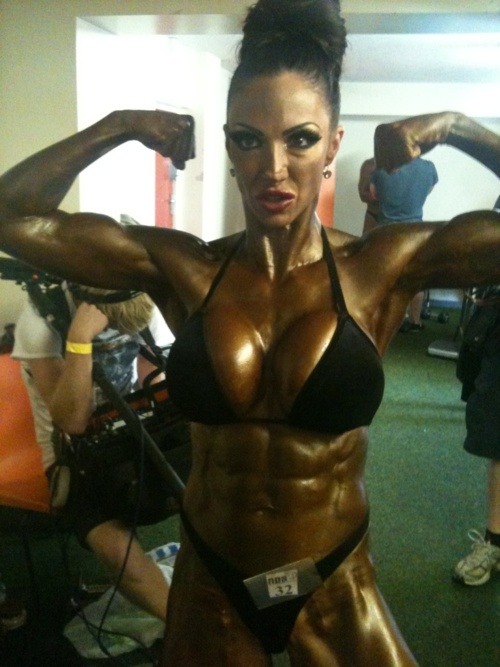
Above: Jodie at the bodybuilding show
How many times a day?
In his audio interview and in this study, Phillips says one should consume 20 g of protein 5-6 times a day. Participants would drink 20 g whole-egg protein dissolved in 400 mL water. “We speculate that no more than 5-6 times daily could one ingest this amount (~20 g) of protein and expect muscle protein synthesis to be maximally stimulated. Protein consumption in excess of this rate or dose would ultimately lead to oxidative loss. In addition, given that the capacity to oxidize amino acids to the diet and can act as a key regulator of protein stores, chronic protein consumption in excess of this rate or dose could actually lead to dampening of the protein synthetic response to suboptimal (i.e., <20 g) protein doses.”

Above: Jodie Marsh

Ingen kommentarer:
Legg inn en kommentar